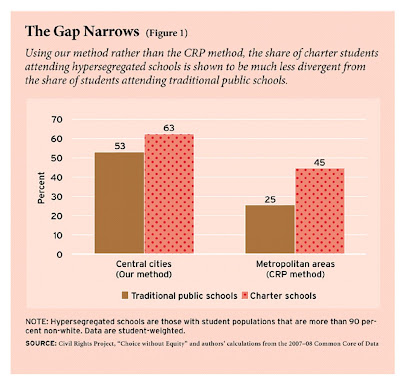There’s a smokescreen of allegations that charter schools are leading to school re-segregation.
Now, a University of Arkansas team takes a look at one specific example of the shaky research behind such claims in a new article in the Summer 2010 edition of Education Next, “A Closer Look at Charter Schools and Segregation.”
“A Closer Look” takes strong issue with the methodology of another recent report from the UCLA-based Civil Rights Project (CRP), claiming that study’s “flawed comparisons lead to overstated conclusions.”
In one, easy to understand example, the Arkansas team points out that if you are looking for data on segregation, you cannot fairly do the job by comparing student demographics of inner city Washington DC charter schools to the demographics of upscale suburban schools that surround Washington.
You have to compare ‘apples to apples’ by looking at the demographics for typical public schools that serve the same population within Washington, DC. Once that is done, assertions about segregation start to crumble.
The University of Arkansas team points out that throughout its analysis of charter schools around the nation, the UCLA crowd’s mistake is to compare charter schools, which are predominantly found in inner city locations that have high minority populations, to much broader geographic areas where far more whites are located.
The Arkansas team provides interesting data that shows this is a very inappropriate comparison. Once inner city charter schools are compared to typical public schools that are also from the inner city, most of the racial gaps between charter and traditional public schools disappear. This graph from the Education Next article shows how that works. 
The two sets of bars on the left show there isn’t much difference in the segregation rates of either typical public schools or charter schools in the inner (central) city. In both cases, there is very high minority presence. In contrast, the set of bars on the right of the graph show the flawed method used by the CRP crowd at UCLA identifies less segregation in both systems but also indicates a much larger gap between charters and typical public schools.
Sadly, this argument highlights yet another case where poor education data hampers understanding. The Arkansas team admits that the available data still isn’t good enough to do a really high quality ‘apples to apples’ comparison. The Arkansas team says that even the gap they show in the left bars of their graph would probably be reduced even more if a better set of data were available. Such data would allow precise tracking of all charter school students back to the typical public school they would otherwise attend.
So, here is another example of how educators are failing to produce the data we all need to analyze how our schools are doing. The lack of that data is leading to smokescreens and confusion about many important education questions including this one about segregation. Considering the huge amount of money we now spend on our public schools, such poor research is simply unacceptable.
Saturday, May 1, 2010
Do charter schools really cause segregation?
Subscribe to:
Post Comments (Atom)


2 comments:
Some charters are for: at risk kids, drop outs, pregnant teens, gay teens, college prep, economically deprived. It depends on the charter.
5 schools in a southern state are culturally diverse and the only one that not is a Title I school.
Charters can’t be stereotyped.
This southern state's plan is to open two more charter schools in an economically deprived area and one in a low socio-economic area.
There are only two ligit concerns about charter schools: management regarding power given or taken by CEO and availability of appeal process for teachers.
Anonymous' (May 2 at 3:28 PM) comments are related to some important points.
First, the variability in charter performance is expected, and actually desirable. These schools are intended to be education laboratories where different approaches can be analyzed. Like any experimental process, some failures are to be expected. But, overall, mankind makes great advances through such a process.
Second, the quality of research on charters is often very poor. I highlighted one example with the main blog posting. In general, it is very difficult to identify a suitable 'apples to apples' comparison group for charter school studies. The ideal would be a true random-sample research project, but none exist to my knowledge.
There are two nearly-random sample type studies available. One by Carolyn Hoxby looked at New York City Charters and the other by a different group looked at Boston charter schools. These rely on the fact that many charter schools are now so competitive that random lotteries have to be run to select students, and a good pool of those who don't get selected is often available as the control group.
Both those nearly-random studies have shown charter schools strongly outperformed the schools that the students would likely otherwise have attended, by the way.
Post a Comment